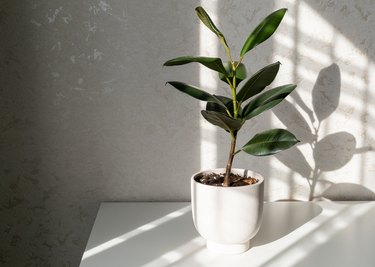
A classic houseplant, the rubber tree plant (Ficus elastica) grows up to 100 feet tall when grown outdoors. Although it's native to Asia, it'll grow outdoors in the warm climates of U.S. Department of Agriculture hardiness zones 10b and 11. You can propagate a new rubber tree plant from a cutting.
Rubber Tree Plant Cutting Techniques
Video of the Day
There are two cutting techniques that work for propagating rubber trees: basic stem cutting and leaf bud cutting. Each requires the same set of tools and supplies. Sterilize a sharp knife in 1 part bleach mixed with 3 parts water. Soak the knife in the solution for five minutes, rinse it with clean water and allow it to air dry.
Video of the Day
You also need a small pot that has a drainage hole and a rooting medium, such as perlite or vermiculite, that allows the stems to be well aerated. Later in the process, you will need a pot filled with a good quality household potting soil.
Wear gloves when working with rubber tree plants because their sap is classified as a level 4 toxin. The milky substance can cause contact dermatitis, so wash your hands thoroughly after touching the plant or its sap.
Rubber Tree Plant Stem Cutting
The first option is to take a plant stem cutting from a larger rubber tree plant. To take a stem cutting, you need to:
- Use the knife to make a slanted cut right below a node, removing 3 to 5 inches of young, active growth with two or more nodes attached. While you could use a rooting hormone, it's not necessary.
- Create a small hole in the rooting medium and place one-half to two-thirds of the stem into the hole, leaving all leaves above the surface.
- Water just until moist and cover the medium back over the stem.
- Enclose the whole pot and plant in clear plastic to prevent drying.
- Keep the cutting in indirect light and between 65 and 72 degrees Fahrenheit. Keep it in the growing medium until the roots are 1/2 to 1 inch long.
Leaf Bud Cutting
Another option is to use a leaf bud cutting. It's a similar process with a slightly different cut. For a leaf bud cutting, you need to:
- Use a sterilized knife to cut off a stem a few inches above the soil.
- Remove 1- to 2-inch sections of new growth at the top of the cut stem, making sure you include a bud and leaf on each.
- Split this small section in half lengthwise, keeping the half with the bud and leaf. This piece is called a mallet.
- Make a small hole in the growing medium and insert the mallet 1 inch below the surface.
- Water it until just moist, then cover with plastic to keep it from drying out. In six to eight weeks, the plant will be rooted and the bud will begin to grow.
Transplanting Rooted Cuttings
You can check if your new rubber tree plants have established roots by carefully tugging on them. When the plant resists the pull, you can transplant the new plant into a larger houseplant pot filled with a quality houseplant potting soil. Always use a pot that has drainage holes.
Place the plant in an area with full sun to partial shade. Rubber tree plants do best with humid and moist environments, so water it regularly and spray the leaves with room-temperature water. Don't allow the soil to stay soggy, but it should be evenly moist. If the leaves yellow or start to fall off, the plant is being overwatered.
For a young plant, fertilize weekly with a standard water-soluble houseplant fertilizer, such as a 12-4-8 formulation, diluted at a rate of 2 teaspoons per gallon. Check the label's rates as they vary by brand.